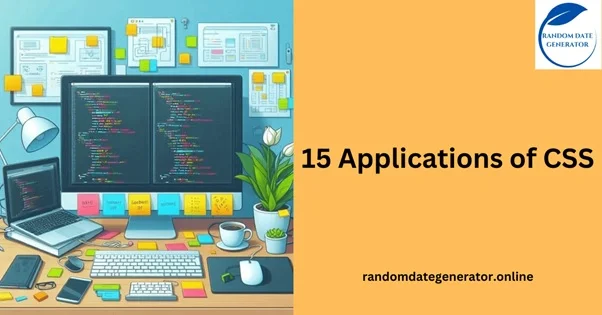Cascading Style Sheets (CSS) is a fundamental technology in web development that allows developers to control the presentation and styling of HTML elements.
From basic styling to complex animations and layouts, CSS plays a crucial role in enhancing the visual appeal and functionality of websites.
In this article, we will explore ten practical applications of CSS that demonstrate its versatility and importance in modern web development.
1. Styling HTML Elements
The primary role of CSS is to style HTML elements, making web pages visually appealing and user-friendly. By defining properties like color, font, size, margins, and padding, CSS enables developers to create consistent and attractive layouts across a website.
2. Using CSS for User Interface Design
One effective application of CSS is enhancing the user interface (UI) of tool sites like a random date generator. By applying CSS techniques such as responsive design, custom fonts, and intuitive color schemes, developers can create a visually appealing and user-friendly experience for visitors using the random date generator tool.
3. Responsive Web Design
CSS plays a pivotal role in creating responsive web designs that adapt seamlessly to different screen sizes and devices. Media queries, flexible grids (e.g., CSS Grid and Flexbox), and fluid layouts allow developers to build websites that provide an optimal viewing experience across desktops, tablets, and smartphones.
4. Creating Animations and Transitions
With CSS animations and transitions, developers can add dynamic elements to websites without relying on JavaScript or external libraries. Keyframe animations, hover effects, and transitions between states enhance user engagement and improve the overall user experience.
5. Implementing Flexibility with Flexbox
CSS Flexbox provides a powerful layout model for designing responsive and flexible container layouts. It simplifies the alignment and distribution of elements within a container, making it ideal for building navigation bars, card layouts, and multi-column grids.
6. Designing Complex Grid Layouts with CSS Grid
CSS Grid Layout allows developers to create intricate grid-based layouts with ease. By defining rows and columns, developers can arrange content in a highly customizable grid structure, facilitating the creation of magazine-style layouts, image galleries, and dashboard interfaces.
7. Customizing Typography
CSS enables precise control over typography on web pages, including font family, size, weight, line height, and letter spacing. Customizing typography not only enhances readability but also contributes to the overall design aesthetic and branding of a website.
8. Creating Modal Windows and Overlays
Modal windows and overlays are common UI patterns used to display additional content or actions without navigating away from the current page. CSS can be used to style and position modal windows, add animations for opening and closing effects, and create overlays that enhance user interaction.
9. Building Navigation Menus
Navigation menus are essential for user navigation within a website. CSS allows developers to create visually appealing and functional navigation menus, including dropdown menus, mega menus, and sticky navigation bars. CSS transitions and hover effects can enhance the interactivity and usability of navigation menus.
10. Implementing CSS Frameworks
CSS frameworks like Bootstrap, Foundation, and Bulma provide pre-built styles and components that streamline the development process. Developers can leverage CSS frameworks to quickly prototype and build responsive websites, saving time and ensuring consistency in design and functionality.
11. Styling Form Elements
CSS allows developers to style form elements such as input fields, checkboxes, radio buttons, and select dropdowns. Customizing these elements not only improves their visual appeal but also enhances usability by making them more intuitive and aligned with the overall design of the website.
12. Creating Print Stylesheets
CSS can be used to create print stylesheets that define how web pages should appear when printed. Print stylesheets allow developers to customize page margins, hide non-essential elements (like navigation bars), adjust font sizes for readability, and ensure that printed pages maintain a professional and consistent appearance.
13. Designing Responsive Images
CSS can be used to ensure images on a website are responsive and adapt to different screen sizes. Techniques like setting max-width: 100% and height: auto ensure that images scale proportionally within their parent containers, preventing overflow and maintaining image quality across devices.
14. Implementing Accessibility Features
CSS can enhance accessibility by styling elements to improve readability and usability for users with disabilities. Techniques include adjusting color contrast for better readability, using: focus styles to highlight interactive elements like links and buttons, and ensuring elements are keyboard-navigable for users who rely on keyboard navigation.
15. Creating Sticky Elements
CSS can be used to create sticky elements that remain fixed in a specific position as the user scrolls through a webpage. This is useful for navigation bars, headers, or sidebars that should always be accessible to users without requiring them to scroll back to the top of the page.
For more information, visit here.









